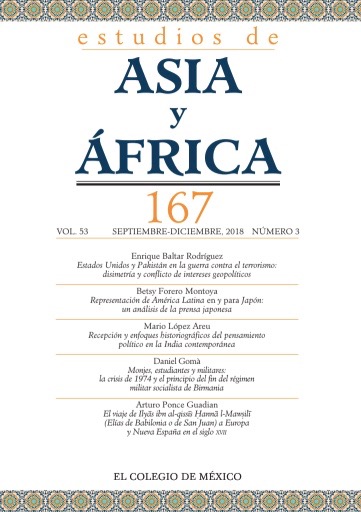Resumen
Este texto parte de los conceptos de alteridad y sistema social autopoiético para analizar la representación contemporánea de lo latinoamericano según el periódico The Asahi Shimbun. Las noticias sobre América Latina publicadas en este diario durante dos décadas se abordan con los métodos de investigación de la comunicación, el análisis de contenido y el análisis textual. De esta manera, se discute cómo la representación resulta primordialmente en una imagen del latinoamericano como deportista o como transgresor del orden, imagen que, a su vez, es el fundamento para la construcción de un otro latinoamericano necesario en la dinámica de producción y reproducción de lo japonés.
Referencias
APICHAI , Shipper, Fighting for Foreigners: Immigration and its Impact on Japanese Democracy, Ithaca, Cornell University Press, 2008.
BEFU, Harumi, Hegemony of Homogeneity: An Anthropological Analysis of Nihonjinron. Melbourne, Trans Pacific Press, 2001.
BERGER, Peter L., y LUCKMANN, Thomas, The social construction of reality: A treatise in the sociology of knowledge, Garden City- Nueva York, Doubleday, 1966.
BHABBA, Homi, “Of Mimicry and Man: The Ambivalence of Colonial Discourse”, Discipleship: A special issue on psychoanalysis, The MIT Press, vol. 28, primavera, 1984, 125-133.
BUTTERWEGGE, Christoph “Mass media, immigrants and racism in Germany: A contribution to an ongoing debate”, Communication: The European Journal of Communication Research, vol. 21, núm. 2, 1996, pp. 203-219.
CREIGHTON, Michael, “Soto Others and uchi Others: Imaging racial diversity, imagining homogeneous Japan”, en M. Weiner (coord.), Japan’s Minorities: The Illusion of Homogeneity, Londres – Nueva York, Routledge, 2009, pp. 211-238.
DOI, Takeo, Amae no kouzou (La estructura de amae), Tokio, Koubundou, 2007.
FORERO MONTOYA, Betsy , “Images of Latin America from the Perspective of Japanese Students”, Journal of International and Advanced Japanese Studies, vol 4, núm. 3, 2012, pp. 67-82.
FUNABIKI, Takeo, Nihonjinron, saiko (Una revisión de Nihonjinron), Tokio, Kondansha, 2010.
GONZALES-LARA, Jorge, “La diáspora peruana un espacio social transnacional: Una aproximación al concepto de Diáspora Peruana”, Construyendo Nuestra Interculturalidad, año 5, núm. 4, 2009, pp.1-8.
HAGIWARA, Shigeru, “Terebi no naka sekai jōsei” (La situación mundial en la televisión), en S. Hagiwara (coord.), Terebi nyuusu no sekaizō (Imágenes del mundo de las noticias: realidad de la construcción del reportaje sobre el extranjero), Tokio, Keiso Shobo, 2007, pp. 23-48.
HAGIWARA, Shigeru, KUNIHIRO, Yoko, Terebi to gaikokujin imeeji: media sutereotaipingu kenkyū (La televisión y la imagen de los extranjeros: una investigación sobre los estreotipos en los medios) , Tokio, Keiso Shobo, 2004.
HALL, Stuart, “The Whites of their Eyes: Racist Ideologies and the Media”, en G. Dines y J. Humez (coord.), In Gender, Race, and Class in Media: A Text Reader, 2003, pp. 89 -93.
HALL, Stuart, “The Work of Representation”, en S. Hall (coord.), Representation: Cultural Representations and Signifying Practices, Londres, Sage, 1997, pp.13-74.
“Ippou Sonokoro Nihondeha” (Por el otro lado en ese momento en Japón) , Colección Japan Class, , Toho Publishing, mayo, 2015.
LEMISH, Dafna, “The Whore and the Other: Israeli Images of Female Immigrants from the Former USSR”, Gender and Society, vol. 14, núm. 2, abril, 2000, abril, pp. 333-349.
LIE, John, “The Discourse of Japaneseness”, en M. Douglass y G. Roberts, Japan and Global Migration: Foreign Workers and the Advent of a Multicultural Society, Londres-Nueva York, Routledge, 2003, pp. 70-90.
LULL, James, “Hegemony”, en G. Dinesl y J. M. Humez (coord.), Gender, Race, and Class in Media: A Text Reader, Thousand Oaks, California, Sage Publications, 2003, pp. 61-66.
OKUBO, Takaki, Nihon Bunkaron no Haifu ―『Bushido』kara 『「Amae」no kouzou』made (Genealogía de la teoría cultural de Japón: desde el bushido hasta la estructura del amae), Tokio, Chuo Koron Shincha, 2003.
RUSSEL, John, “The other other”, en M. Weiner (coord.), Japanese Minorities: The Illusion of Homogeneity, Londres-Nueva York, Routledge, 2009, pp. 84-115.
STASZAK, Jean-Francois, “Other/otherness”, en R. Kitchin y N. Thrift (coord), International Encyclopedia of Human Geography, Elsevier Oxford, vol. 8, 2008, pp. 43-47.
TSUDA, Takeyuki, “Domesticating the Immigrant Other: Japanese Media Images of Nikkeijin Return Migrants”, Ethnology: An International Journal of Cultural and Social Anthropology , vol. 42, núm. 4, 2003, pp. 289-305.
UMEHARA, Takeshi, Nihon Bunkaron (Teoría cultural de Japón), Tokio, Kodansha, 1986.
Esta obra está bajo una licencia internacional Creative Commons Atribución-NoComercial-SinDerivadas 4.0.
Derechos de autor 2022 Estudios de Asia y África


